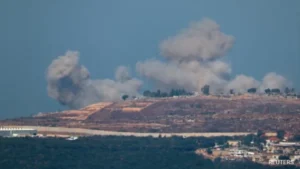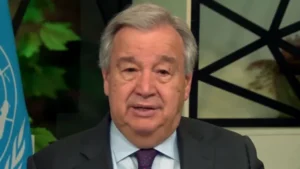China’s 3 Days military drills in Taiwan Strait
China has recently begun a three-day military drill in the Taiwan Strait, which has caused quite a stir in the international community. The drill is believed to be a show of strength and a warning to Taiwan and the United States, which has been a long-time ally of Taiwan. The exercise comes at a time when tensions between China and Taiwan are already high, and the world is watching closely to see what the implications of this move may be.

China has recently begun a three-day military drill in the Taiwan Strait, which has caused quite a stir in the international community. The drill is believed to be a show of strength and a warning to Taiwan and the United States, which has been a long-time ally of Taiwan. The exercise comes at a time when tensions between China and Taiwan are already high, and the world is watching closely to see what the implications of this move may be.
The military drills started on April 13th and are set to continue until April 15th. According to Chinese officials, the drills are meant to test the military’s capabilities and are not directed at any particular country. However, the timing of the exercise has raised concerns, as it coincides with the visit of a high-level US delegation to Taiwan.
The relationship between China and Taiwan has always been complex, with tensions simmering just below the surface. However, in recent years, these tensions have escalated, with China taking a more aggressive stance towards Taiwan. China has increased its military presence in the Taiwan Strait, and has also been using its economic might to try and isolate Taiwan from the international community.
The United States, which is a long-time ally of Taiwan, has been watching these developments closely, and has been providing military and economic support to the island nation. This has not gone down well with China, which sees this as interference in its internal affairs.
The military drills in the Taiwan Strait come at a time when tensions between China and the United States are also high. The two countries are currently engaged in a trade war, and are also at odds over a number of other issues, including human rights and China’s territorial claims in the South China Sea.
The United States has responded to the military drills by sending a high-level delegation to Taiwan. The visit of the US delegation is seen as a show of support for Taiwan, and a clear message to China that the United States is committed to defending Taiwan’s democracy and sovereignty. This is likely to further inflame tensions between the two countries, and may lead to further military posturing in the region.
It is worth noting that this is not the first time that China has conducted military drills in the Taiwan Strait. In fact, such drills have become more common in recent years, as China seeks to demonstrate its military might and assert its dominance in the region. However, the timing of this particular exercise is significant, as it coincides with the visit of the US delegation to Taiwan.
The military drills in the Taiwan Strait also come at a time when the world is grappling with the COVID-19 pandemic. This has led to concerns that China may be taking advantage of the global situation to further its own interests, and that the military drills may be a distraction from the more pressing issues facing the world.
In conclusion, the military drills in the Taiwan Strait are a clear indication of the escalating tensions between China and Taiwan, as well as between China and the United States. While Chinese officials have stated that the drills are not directed at any particular country, the timing of the exercise suggests otherwise. The visit of the US delegation to Taiwan is likely to further inflame tensions, and may lead to further military posturing in the region.
The situation in the Taiwan Strait is complex and has been a long-standing issue in international relations. The issue dates back to the end of the Chinese civil war in 1949, when the Chinese Communist Party (CCP) defeated the Nationalist Party (Kuomintang) and established the People’s Republic of China (PRC) on the mainland. The Nationalist government fled to Taiwan, where it established the Republic of China (ROC) and continued to claim sovereignty over all of China, including the mainland.
For many years, the international community recognized the ROC as the legitimate government of China, and Taiwan held a seat in the United Nations. However, in 1971, the UN passed a resolution recognizing the PRC as the sole representative of China, and Taiwan was expelled from the organization. Since then, the international community has followed a “one China” policy, recognizing the PRC as the only legitimate government of China, but also acknowledging the existence of Taiwan as a de facto sovereign state.
Despite this, the CCP has continued to maintain that Taiwan is a part of its territory and has never renounced the use of force to bring the island under its control. This has led to a tense standoff between China and Taiwan, with both sides engaging in military posturing and brinksmanship.
The military drills in the Taiwan Strait are just the latest example of China’s assertiveness towards Taiwan. In recent years, China has increased its military presence in the region, conducted military exercises, and engaged in diplomatic pressure to isolate Taiwan from the international community. China has also been using its economic leverage to pressure countries to sever ties with Taiwan, and has successfully convinced a number of countries to do so.
The United States has been a key ally of Taiwan, providing military and economic support to the island nation. This has been a source of tension between the United States and China, which sees this as interference in its internal affairs. The US has also been pushing back against China’s aggressive actions in the region, including conducting freedom of navigation operations in the South China Sea and increasing military cooperation with other countries in the region.
The situation in the Taiwan Strait is complicated by the fact that it is not just a bilateral issue between China and Taiwan, but also involves the United States and other regional players. Japan, for example, has also been increasing its military presence in the region, and has been cooperating with the US to monitor Chinese activities in the East China Sea.
The military drills in the Taiwan Strait also come at a time when the world is grappling with the COVID-19 pandemic. This has led to concerns that China may be taking advantage of the global situation to further its own interests, and that the military drills may be a distraction from the more pressing issues facing the world.
The international community has responded to the military drills with concern, with some countries urging China to exercise restraint and avoid any actions that could escalate tensions in the region. The United States has also reiterated its commitment to defending Taiwan’s democracy and sovereignty, and has called on China to respect the status quo in the region.
The situation in the Taiwan Strait is likely to remain tense in the coming months and years, as China continues to assert its dominance in the region and the United States continues to push back against these actions. The military drills in the Taiwan Strait are just one example of the complex and evolving situation in the region, and it remains to be seen how it will play out in the long term.
China’s recent military drills in the Taiwan Strait have raised concerns among the international community about the escalating tensions in the region. The exercises, which lasted for three days, involved Chinese fighter jets and naval vessels and were seen as a show of force against Taiwan.
The military drills in the Taiwan Strait come at a time when tensions between China and the United States are already high. The two countries have been engaged in a trade war and a series of diplomatic disputes, and the United States has been pushing back against China’s assertiveness in the South China Sea.
The military drills are seen as a response to recent moves by the United States to strengthen its ties with Taiwan. In August, the United States announced it would sell Taiwan 66 F-16 fighter jets, a move that was criticized by China as a violation of its sovereignty. The United States has also been increasing its military presence in the region, conducting freedom of navigation operations in the South China Sea and increasing military cooperation with other countries in the region.
The situation in the Taiwan Strait is complicated by the fact that it is not just a bilateral issue between China and Taiwan, but also involves the United States and other regional players. Japan, for example, has also been increasing its military presence in the region, and has been cooperating with the US to monitor Chinese activities in the East China Sea.
The military drills in the Taiwan Strait have been met with concern by the international community, with some countries urging China to exercise restraint and avoid any actions that could escalate tensions in the region. The United States has also reiterated its commitment to defending Taiwan’s democracy and sovereignty, and has called on China to respect the status quo in the region.
Despite the concerns raised by the military drills, there are also some who believe that China’s actions are not as aggressive as they may seem. Some experts argue that the drills were intended as a warning to Taiwan, rather than as a prelude to an invasion. Others point out that China has conducted military exercises in the Taiwan Strait before, and that this is not an unprecedented move.
Regardless of the intentions behind the military drills, the situation in the Taiwan Strait is likely to remain tense in the coming months and years. China is unlikely to back down from its position on Taiwan, and the United States is unlikely to abandon its support for the island nation. The military drills in the Taiwan Strait are just one example of the complex and evolving situation in the region, and it remains to be seen how it will play out in the long term.
Conclusion
China’s recent military drills in the Taiwan Strait have raised concerns about the escalating tensions in the region. The situation in the Taiwan Strait is a longstanding issue in international relations and is complicated by the involvement of the United States and other regional players. While some experts believe that China’s actions are not as aggressive as they may seem, the situation is likely to remain tense in the coming months and years.

Continuing the achievement of the journey of effectiveness and credibility of more than 10 years in the career of journalism, as a woman journalist, I am Serving as the founder, promoter and editor of DiaryTimes with the trust and support of all. My credible coverage may not have given a big shape to the numbers, but my journey presents articles that make you aware of the exact and meaningful situations of Himachal’s politics, ground issues related to the public, business, tourism and the difficult geographical conditions of the state and financial awareness. DiaryTimes, full of the experience of my precise editorial expertise, is awakening the flame of credible journalism among all of you, so that the eternal flame of meaningful change can be lit in the life of the people of the state and the atrocities being committed against the people can be brought to the fore, I am motivated for that. If even a small change comes with the power of my journalism and the whole world becomes a witness to that issues, then I will consider myself fortunate.





